NATIONAL AGING AND DISABILITY TRANSPORTATION CENTER (NADTC)
KRC RESEARCH
Executive Summary
Most older adults and younger adults with disabilities drive their own vehicles or ride with family or friends. Some supplement with public and other forms of transportation. Incentives to use other modes appear limited.
- About three-quarters of adults with disabilities of all ages ride with family and friends, compared to just over half of those without disabilities.
- About a third of younger adults with disabilities use public transportation, ride with a volunteer, and/or use special transportation services for people with disabilities.
- Only 15% of older adults use public transportation and even fewer use special transportation services or ride with a volunteer.
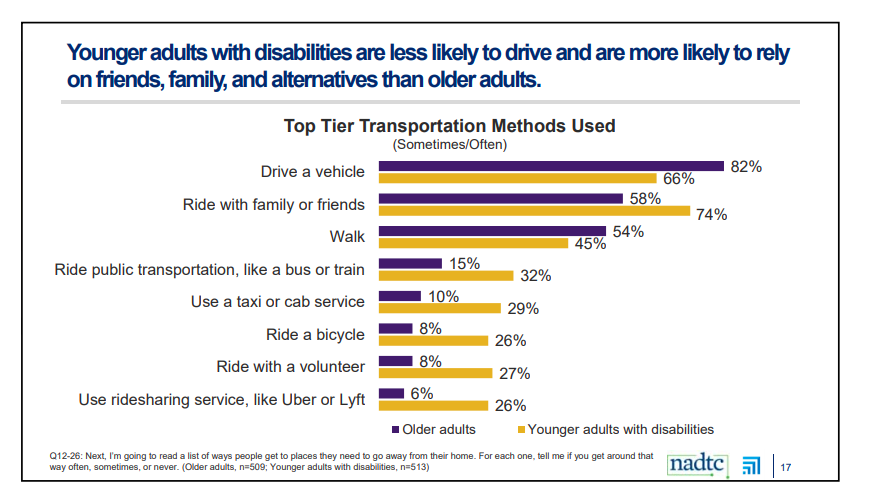
While I was doing research to get a caregiver for mom, I found out that caregivers play a pivotal role in helping older adults and individuals with disabilities meet their transportation needs—and most are happy to help.
- Two in 10 older adults and six in 10 people with disabilities have a caregiver. Most caregivers live with the care recipient, or close by.
- Caregivers spend about five hours a week either providing transportation or arranging for it.
- Caregivers are quite concerned about the safety of the person they care for if they are still driving. Most expect a time will come when the care recipient will no longer be able to drive.
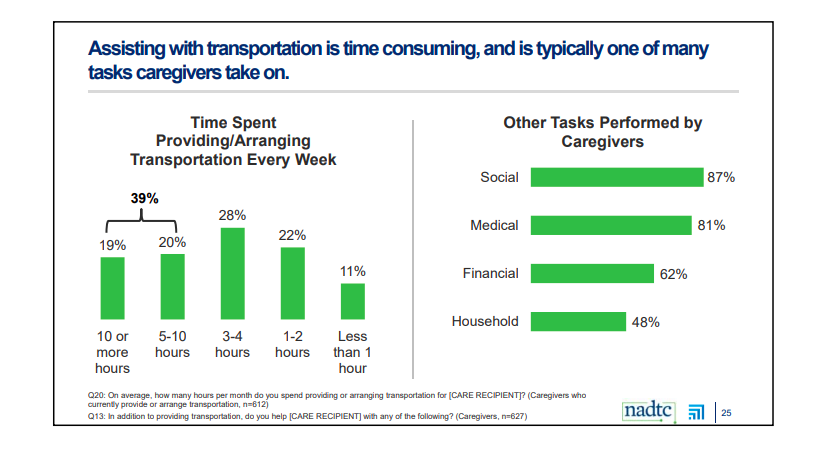
Many individuals with disabilities of all ages have concerns about driving and so have cut back or made adjustments. Across age and disability, most anticipate a time when they will no longer be able to drive.
- Those who have made changes to their driving because of a visual, physical, or medical challenge have cut back, only drive when necessary, and avoid driving at night.
- Older adults estimate they will need to stop driving around the age of 80, while younger adults with disabilities estimate they will stop at age 60.
- Most say it will be extremely difficult to find alternative forms of transportation when they give up driving.
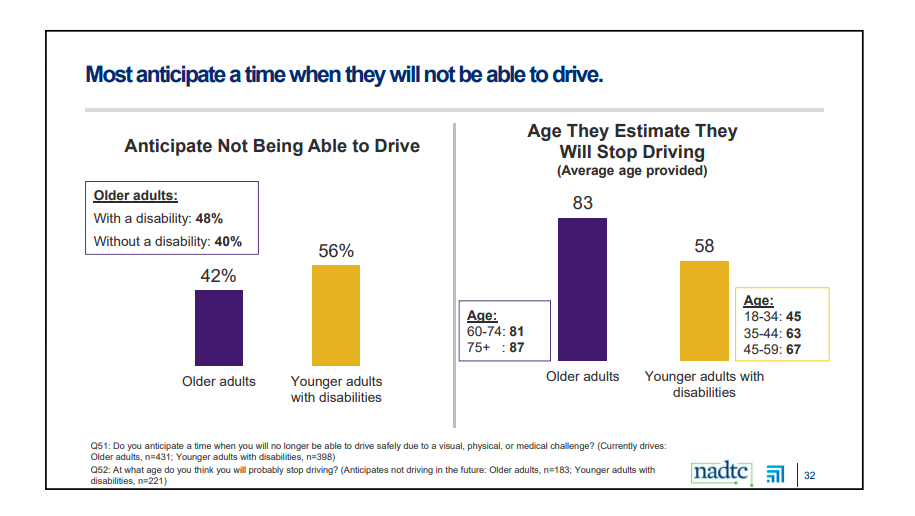
Those who give up driving face big barriers getting around. They can no longer do the things they need and want to do. They face physical isolation, frustration, and feel dependent and trapped.
- Older adults who gave up driving did so because were no longer comfortable, while those with disabilities gave it up due to physical and medical challenges.
- Most say that alternative options for getting around are good, but could be better—only about a quarter say they have excellent options. Options are especially limited in rural areas.
- Not driving is a huge barrier, especially for younger adults with disabilities. Barriers include expensive and sparse transportation options.
- Close to 9 in 10 who stopped driving have been negatively impacted—from being isolated to dependent. This limits them living their lives to the fullest and makes them feel frustrated.
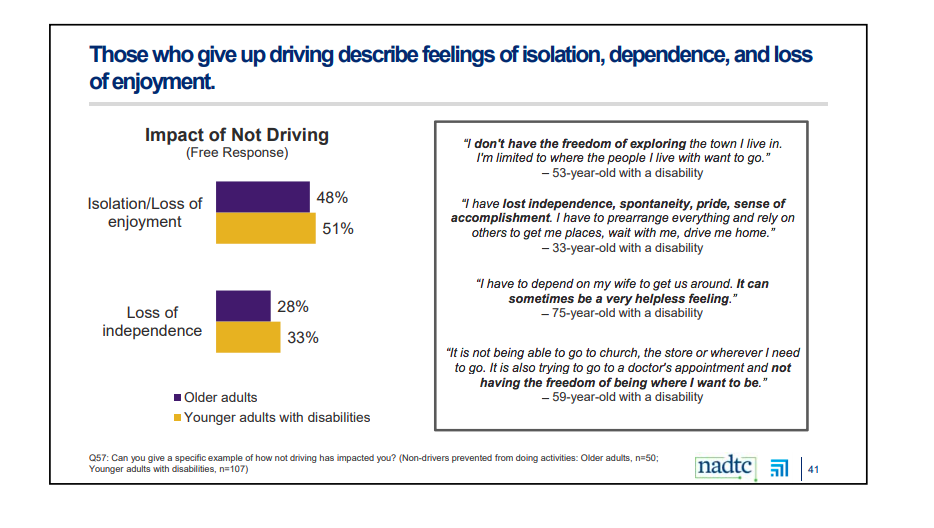 Older adults and younger adults with disabilities who do not drive face many barriers, including access to affordable transportation alternatives.
Older adults and younger adults with disabilities who do not drive face many barriers, including access to affordable transportation alternatives.
- Availability of alternative options (including public transportation, like trains and buses) is the biggest barrier, followed by cost.
- Even though cost is a barrier for many, people do not seem to be using discounted rides or vouchers.
- Majorities are familiar with alternative transportation options, but those in rural areas are less familiar than those in urban areas.

There is no single “go-to” information resource for alternative transportation options. Many turn to family and friends for information about options.
- Few are familiar with public transportation options; only about a quarter say they are very familiar.
- Outside of friends and family, most are not taking advantage of local information about transportation.
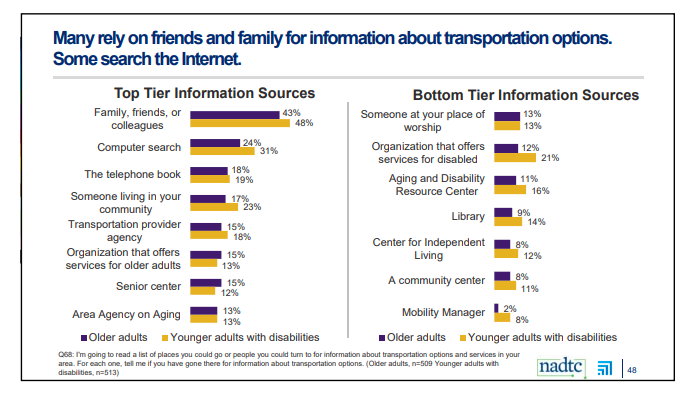
Most hope for more convenient and public alternatives in the future. Younger adults with disabilities are more optimistic about improvements than older adults.
- Younger adults with disabilities are more hopeful than older adults that options will get better.
- Greater availability of convenient public transportation is the number one request.
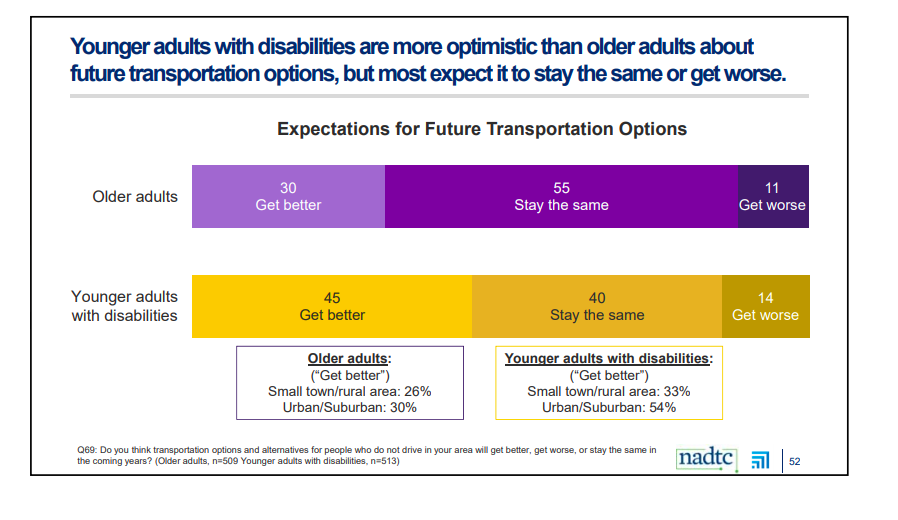
Download full version (PDF): Transportation Needs and Assessment
About the National Aging and Disability Transportation Center (NADTC):
www.nadtc.org
NADTC’s goal is to promote the availability and accessibility of transportation options for older adults, people with disabilities and caregivers. The National Aging and Disability Transportation Center (NADTC) is a program funded by the Federal Transit Administration and administered by Easterseals and the National Association of Area Agencies on Aging (n4a) with guidance from the U.S. Department of Health and Human Services, Administration for Community Living.
About KRC Research:
www.krcresearch.com
KRC Research is a global full-service public opinion research consultancy. Our global quantitative and qualitative market research solutions help inform strategic decisions, optimize strategies, fuel thought leadership, and drive headlines.
Tags: disabilities, driving, KRC Research, NADTC, National Aging and Disability Transportation Center






 RSS Feed
RSS Feed